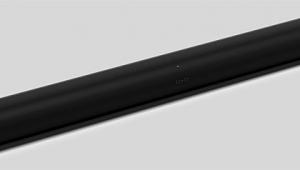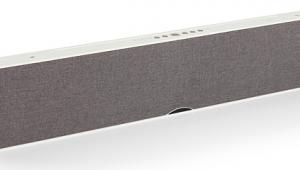Darryl,
Nice review. I enjoyed reading it. Do you like the PB-235 over the ZVOX 580? At 6" tall, the AT would block some of my tv screen - not to mention the remote signal. So, it would not be an option for me.
Atlantic Technology PB-235 PowerBar Soundbar

Frank•en•bar [frang-kuhn-bahr]: noun 1) a soundbar with parts and pieces taken from traditional home theater systems—processor, switcher, amplifier, remote control, speaker drivers, etc.—which are bolted together into a single cabinet and shocked into life with one power cord. The typical Frankenbar has a dual purpose: a) to provide much-improved sound quality over that produced by the speakers built into modern televisions (such an easy task, by the way, that it could seemingly be accomplished by a couple of tin cans and a string); while at the same time b) significantly reducing the number of boxes in the system, as well as dramatically simplifying the installation process. 2) The ultimate example of an all-in-one integrated system, except for the fact that virtually every Frankenbar—or any soundbar, for that matter—usually requires a subwoofer in order to sound acceptable to the human ear. This mandatory subwoofer, by virtue of being a physical object that takes up floor space, is more often than not considered both an eyesore and may in some areas be legally acceptable grounds for divorce.
Sell the Sizzle
For well over a year, Peter Tribeman, Atlantic Technology’s founder and obscure-movie-clip devotee, has been showing off prototypes and making bold claims for the company’s latest Frankenbar, the PB-235 PowerBar with H-PAS technology Without a hint of modesty, he boasted that, for under $900, the new all-in-one, powered soundbar would be extremely musical, capable of filling even fairly large rooms with remarkably believable 5.1-channel effects (as well as unbelievable two-channel performance), and—here’s where he seemed to be going off the deep end—it would be the world's first and only soundbar that didn’t absolutely require a subwoofer. This would be the case, he promised, because the new H-PAS PowerBar-235 is claimed to be capable of producing respectable amounts of bass down to as low as 47 hertz.
Forgive me if I smell the stinging scent of sizzling snake oil in the air. Without the crucial aid of a subwoofer, not many soundbars are lucky to get within spitting distance of 100 Hz, and a disproportionally large number don’t have a prayer in hell of getting below twice that frequency. Sadly, even some of the subwoofers that are packaged with soundbars struggle to get to 47 Hz at a reasonable level. While it’s obvious that you’d want the subwoofer to go as low as possible, what difference does it make if the soundbar itself can’t go down to 100, 150, or even 200-plus Hz? Can’t the crossover point on the subwoofer be adjusted upward so the sub can output the bass frequencies the soundbar lacks?
That, as a matter of fact, is exactly how many companies design soundbar/subwoofer combos. Relying on the “subwoofer” to produce lots of midbass isn’t necessarily a big deal if the soundbar sits directly on top of the subwoofer. But since sound waves above 80 Hz or so start to become more directional the higher the frequency is, there’s trouble waiting for any system in which the midbass-cranking subwoofer isn’t located in close proximity to the soundbar. Separate the sub from the soundbar, and what you’ll hear is a sometimes not so subtle smearing, or even a jumping of the apparent point of origin, of low sounds and deep voices between the soundbar and sub. James Earl Jones’s voice of Darth Vader may be bigger than life, for example, but it’s not supposed to sprawl fat and sloppy halfway across the room. The effect is more prevalent when you’re closer to the sub than you are to the soundbar, so if you’ve hidden the sub behind the couch where you’re sitting to keep it out, you’ll probably notice it more than if the sub were in the front of the room or a far corner. Seamless coherency between the bass and midrange is a key reason a soundbar that can reach low into the bass range is potentially desirable. But how do you make that happen?

Four Inches Is Supposed to Impress Me?
I’ll give you the standard stuff about the PB-235 first. It’s a modest 42.75-inch-wide soundbar that’s 6.5 inches high and 6.5 inches deep. The left and right sides are slightly curved, and there’s a 9-inch-wide by 1-inch-tall arched Control Pod on the top of the cabinet. Located on the front-facing side of the Control Pod are the power button, the volume up/down buttons, a Mode button, a window for the built-in IR receiver, a 3.5mm minijack audio input, and a status display window. On the back of the Control Pod are the PowerBar’s four other audio inputs (a coax digital, two optical digital, and a stereo pair of analog RCAs), an analog subwoofer output (with dedicated on/off button), an input for an external IR eye, and a jack for the external power supply. The PB-235’s front and sides are covered by a black cloth grille, while the top, bottom, and back have a painted black finish, giving the speaker a traditional, low-key look. The soundbar can be mounted on the wall using keyhole slots on the back, and there are threaded inserts for use with an optional wall-mount bracket or to otherwise attach the PowerBar to a flat-panel HDTV’s wall mount or stand. The soundbar comes pre-configured to use with the Control Pod oriented on top, but you can quickly flip and reconfigure it to operate with the Control Pod on the bottom—in which case, the display window’s text rotates 180 degrees, and the left and right audio inputs are internally swapped. Atlantic Technology includes an alternate faceplate with the labels oriented properly for use when the Control Pod is on the bottom. The PowerBar also comes with a rectangular, basic IR remote control that’s about the size of a Nutter Butter cookie. (The regular ones, not the Bites.)
If you bothered to wade through the details, you might have noticed the absence of HDMI connections. The PowerBar doesn’t do video, so if you want to hook up a Hopper, a Blu-ray player, an Apple TV, or a Roku box, as well as your laptop, you’re going to have to do the video switching through your TV. No HDMI also means no DTS-HD Master Audio or Dolby TrueHD decoding for Blu-ray discs, though this is common for most soundbars.
What’s behind the grille is almost incomprehensible when you consider that the PB-235 is supposed to be able to create a simulated 5.1-channel effect even in large rooms in addition to breaking the sub-50-Hz bass barrier. All you’ll find on the front baffle is a 4-inch cone bass driver and 0.75-inch tweeter combo on the far left side with a mirror-image combo on the right. Near each tweeter is a rectangular (2.75 inches wide by 1.25 inches tall) forward-firing port. There are no other drivers or passive radiators.
- Log in or register to post comments






































































